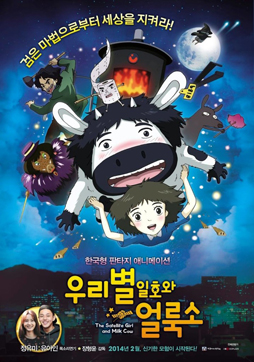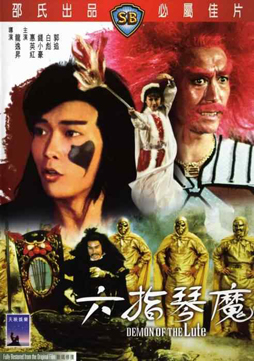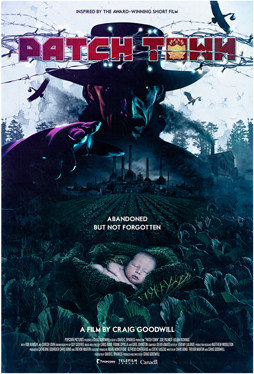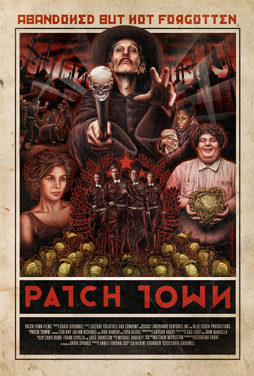My Fantasia Festival, Day Three (Part One): The Satellite Girl and Milk Cow, Demon of the Lute, and Patch Town
 Saturday was my first really big day at Fantasia. On weekdays, the festival usually starts its screenings at 5 or 6, with the occasional matinée at 3. Weekend days kick off around noon, meaning many more movies are on offer. Which also incidentally increases the risk of losing track of the need for a meal. I ended up seeing five movies last Saturday, with a dinner break after the first three. So this post will cover those first three films and I’ll have another up shortly looking at the next two. (In general it seems like I’m going to have more Fantasia posts than I’d thought, as I try to keep up with the films I’ve watched.)
Saturday was my first really big day at Fantasia. On weekdays, the festival usually starts its screenings at 5 or 6, with the occasional matinée at 3. Weekend days kick off around noon, meaning many more movies are on offer. Which also incidentally increases the risk of losing track of the need for a meal. I ended up seeing five movies last Saturday, with a dinner break after the first three. So this post will cover those first three films and I’ll have another up shortly looking at the next two. (In general it seems like I’m going to have more Fantasia posts than I’d thought, as I try to keep up with the films I’ve watched.)
I started at the Hall Theatre at 11:40 with an animated film from Korea called The Satellite Girl and Milk Cow. As soon as that ended, I ran across the street to the smallest of the three main Fantasia theatres, the J.A. De Sève, where I watched the wild Shaw Brothers kung-fu film Demon of the Lute. After which I stayed with the De Sève to watch the Canadian feature Patch Town, which turned out to be a charming, surreal fantasy. It was a good, if somewhat lunatic, afternoon.
(Incidentally, the reason why I mention the theatres in which the movies are playing is because after a few days, it seems like each one has developed its own personality. Big broad-appeal films play at the Hall — bearing in mind that ‘broad appeal’ at Fantasia can mean something like Zombeavers as well as Guardians of the Galaxy. The D.B. Clarke seems to host a lot of thoughtful films with fairly high production values. And the De Sève has featured a number of experimental films and documentaries, as well as screenings of older films and the occasional thriller or horror movie.)
 Written and directed by Chang Hyung-yun, The Satellite Girl and Milk Cow (original title: Wuribyeol Ilhowa Eollukso) has an engagingly bonkers premise: a Korean satellite, Kitsat-1 — an actual satellite launched in 1992, Korea’s first — falls in love with a musician she’s observed from orbit. So Kitsat takes the shape of a girl, Il-ho, to find him. But the musician, Kyung-chun, has been turned into a cow because his heart is broken; heartbroken people in this movie turn into animals, and are hunted down by a man who wants to pull their livers out with a plunger. Meanwhile, a giant fear-robot called the Incinerator is causing havoc. Luckily, Kyung-chun gets help from Merlin the magician, blood heir of fairies, who due to an unfortunate series of circumstances is now in the form of a roll of toilet paper.
Written and directed by Chang Hyung-yun, The Satellite Girl and Milk Cow (original title: Wuribyeol Ilhowa Eollukso) has an engagingly bonkers premise: a Korean satellite, Kitsat-1 — an actual satellite launched in 1992, Korea’s first — falls in love with a musician she’s observed from orbit. So Kitsat takes the shape of a girl, Il-ho, to find him. But the musician, Kyung-chun, has been turned into a cow because his heart is broken; heartbroken people in this movie turn into animals, and are hunted down by a man who wants to pull their livers out with a plunger. Meanwhile, a giant fear-robot called the Incinerator is causing havoc. Luckily, Kyung-chun gets help from Merlin the magician, blood heir of fairies, who due to an unfortunate series of circumstances is now in the form of a roll of toilet paper.
This is all quite mad, of course. But the movie swiftly settles down, and in fact becomes more conventional as it goes along, taking on the shape of a relatively standard romantic comedy. The various weirdnesses come to serve as symbolic ideas that bring out aspects of the relationship between Il-ho (voiced, it says here, by Jung Yu-mi) and Kyung-chun (Yoo Ah-in). In that sense, it’s a well-machined fantasy story, where the fantastic elements drive the plot and bring out the theme. You wouldn’t think it from the first ten minutes or so, but in fact one of the film’s issues is that it’s too conventional; you can see plot points coming, and the relationship of the two leads develops less according to any logic of its own than according to the logic of the genre.
 Another and I think more serious problem is that Kyung-chun’s not an especially sympathetic romantic lead. His heart’s broken at the start of the movie because he was in love with a woman for five years, but never told her so. There’s actually a scene where he accuses her of knowing how he felt, and of trifling with his affections. I found it hard to swallow; he seemed to be blaming her for his own lack of honesty, and faulting her for her distinterest in him. Given that Il-ho comes off as being unused to human emotions, the relationship between her and Kyung-chun is less touching than it might have been.
Another and I think more serious problem is that Kyung-chun’s not an especially sympathetic romantic lead. His heart’s broken at the start of the movie because he was in love with a woman for five years, but never told her so. There’s actually a scene where he accuses her of knowing how he felt, and of trifling with his affections. I found it hard to swallow; he seemed to be blaming her for his own lack of honesty, and faulting her for her distinterest in him. Given that Il-ho comes off as being unused to human emotions, the relationship between her and Kyung-chun is less touching than it might have been.
Visually, Satellite Girl’s quite a nice movie: brightly-coloured and well-animated. The character designs are on the whole effective, particularly the more outlandish. The artists responsible did a good job of finding a style that made robots and talking cows and witches in the shape of wild boars all coherently coexist with each other and with everyday humans (some of whom happen to be satellites). It all moves along efficiently enough, though with the occasional musical interlude. (I did notice an apparent continuity error which confuses the story: Merlin makes a human ‘costume’ for Kyung-chun, which the movie shows us is very fragile. Then Kyung-chun falls in a pond and the costume doesn’t break. I thought at first that was a way of saying he was over his heartbreak, back in human form, and in love with Il-ho; but no, the movie and love story kept going.)
The movie’s sweet and pleasant to look at. It’s efficient at balancing humour and melodrama, and generally hits the marks it aims for in both departments. It hides a very conventional approach under some genuinely weird ideas, and whether you like the film or are left disappointed by it will likely depend on whether you prefer the utterly unpredictable or competently-executed formula with a twist.
 As it happens, the next movie I saw made an interesting contrast. If Satellite Girl begins with weirdness and becomes more conventional, Demon of the Lute begins with weirdness and really commits to that weirdness, becoming stranger as it goes on until it evolves into something near-hallucinatory. Made in 1983, Lute (originally Liu Zhi Qin Mo) was directed and written by Lung Yi Sheng from a story by Kuang Ni. It’s not in any way a good movie. It is in fact cheerfully unconcerned with being a ‘good movie.’ But it’s one of the most damned entertaining bad movies I’ve ever seen in my life.
As it happens, the next movie I saw made an interesting contrast. If Satellite Girl begins with weirdness and becomes more conventional, Demon of the Lute begins with weirdness and really commits to that weirdness, becoming stranger as it goes on until it evolves into something near-hallucinatory. Made in 1983, Lute (originally Liu Zhi Qin Mo) was directed and written by Lung Yi Sheng from a story by Kuang Ni. It’s not in any way a good movie. It is in fact cheerfully unconcerned with being a ‘good movie.’ But it’s one of the most damned entertaining bad movies I’ve ever seen in my life.
The plot starts out as though it could be a straight-ahead fantasy adventure: there’s an evil magic lute in the hands of a bad guy, the Demon of the Lute, who has a collection of thugs in nice red uniforms. An old sage (Kwan Feng) sends his heroic pupil, a woman named Feng Ling (Kara Hui) out to win the items that will lead to the Demon’s defeat. A three-armed thief and his young son join her. There’s a young blacksmith from a country village who gets involved. And elves. And magic swords. And a magic bow. And a jade seal with a hidden map. And a guy with an elastic arm. And another guy with wings. And a bald guy who grows a red wig and an enormous axe. And, and, and —
The movie never stops throwing in new elements. It’s always adding heroes, villains, macguffins, and everything else you can think of. And all of it overacts, even the inanimate objects. This is a movie where people don’t just grip weapons, they squeeze hilts so tightly blood spurts from between their fingers. They don’t just smile if they’re happy, they do backflips. There’s no technique this movie won’t use, over and over and over, with no regard for realism whatsoever. Key shots in a fight scene are in slow-motion, or repeated twice. Unconvincing wirework is almost as common as fake rocks. Props are made ‘magical’ by being covered in foil or glitter. The costumes and the sound effects seem to compete to see which can be more over-the-top (they both win). There’s more dry ice in this movie than a Spinal Tap stage show. Understand that all these things that I am saying are being said not in mockery, but in something more like awe. The complete and total lack of irony builds a world of its own, demented, cheerful, and tasteless.
 It’s a kid’s film; the thief’s son is a six-year-old, and one of the most important characters in the movie. I dearly wish I’d seen it when I was six or eight. There may be a bit more fake blood than in most children’s movies, but the berserk imaginativeness I think would speak directly to a younger viewer. The special effects are archaic, but there’s something to be said for producing the image of a guy backflipping through explosions not through CGI but by having a guy actually do backflips through actual small explosions (they borrowed Tap’s pyro as well as the dry ice).
It’s a kid’s film; the thief’s son is a six-year-old, and one of the most important characters in the movie. I dearly wish I’d seen it when I was six or eight. There may be a bit more fake blood than in most children’s movies, but the berserk imaginativeness I think would speak directly to a younger viewer. The special effects are archaic, but there’s something to be said for producing the image of a guy backflipping through explosions not through CGI but by having a guy actually do backflips through actual small explosions (they borrowed Tap’s pyro as well as the dry ice).
Once I realised what I was watching, I had a blast with this film. The fight choreography’s solid, if unspectacular, and while the movie keeps giving the heroes new quests and introducing new plot coupons, it never contradicts itself or feels overlong. It’s a solid story — a lighthearted, overstuffed, unpredictable, hugely entertaining story.
After Demon of the Lute came Patch Town, and I have to give the Fantasia programmers full marks here. Demon of the Lute would strike me as the sort of movie that it’s almost impossible to follow. But Patch Town was exactly the right choice. It’s vaguely similar, a fantasy tinged with comedy that tells a story seriously while at the same time not taking itself too seriously. But it’s different enough in every other way that the contrast works.
 Directed by Craig Goodwill from his own previous short film version, written by Goodwill along with Trevor Martin and Christopher Bond, it opens in a pseudo-Soviet industrial setting where workers are cutting open cabbages to reveal babies. Which are then frozen, in a kind of suspended animation, into doll shape. The doll-babies, grown in a cabbage patch not far from this far-northern factory, will be sold to kids around the world — and, when the dolls are eventually discarded years down the road, they’ll be brought back to the factory, unfrozen, and put to work. Jon (Rob Ramsay) is one of these workers; he lives with his wife Mary (Stephanie Pitsiladis), and together they’ve stolen a cabbage-child. Jon gets a lead on the identity of the now-grown girl to whom he once belonged — who he considers his mother — leading to him and Mary fleeing the factory in the company of manic bus driver Sly (Suresh John). But the sinister Yuri, master of the factory, has his own plans.
Directed by Craig Goodwill from his own previous short film version, written by Goodwill along with Trevor Martin and Christopher Bond, it opens in a pseudo-Soviet industrial setting where workers are cutting open cabbages to reveal babies. Which are then frozen, in a kind of suspended animation, into doll shape. The doll-babies, grown in a cabbage patch not far from this far-northern factory, will be sold to kids around the world — and, when the dolls are eventually discarded years down the road, they’ll be brought back to the factory, unfrozen, and put to work. Jon (Rob Ramsay) is one of these workers; he lives with his wife Mary (Stephanie Pitsiladis), and together they’ve stolen a cabbage-child. Jon gets a lead on the identity of the now-grown girl to whom he once belonged — who he considers his mother — leading to him and Mary fleeing the factory in the company of manic bus driver Sly (Suresh John). But the sinister Yuri, master of the factory, has his own plans.
The instantly recognisable cheekbones of veteran Canadian character actor Julian Richings have haunted many a film and TV show; here he steals the movie as the sinister Yuri — alternately disturbingly sinister and clownishly sinister, switching registers effortlessly. But it’s not as if the rest of the cast is poor. Ramsay’s a consistently sympathetic figure, and Pitsiladis manages the trick of making Mary commonsensical without being a killjoy (I’ll also note that Ramsay and Pitsiladis are both overweight, and there’s something refreshing in seeing a movie with a non-standard sense of beauty in its leads).
Visually, the movie’s well done, particularly the dieselpunk factory setting. It’s a well-shot movie in general, using shadow and darkness effectively without ever becoming murky. It’s hard not to think of Tim Burton while watching it, but there’s a restraint here largely foreign to Burton. Even if some of that’s a function of budget, the point is that the movie works with its limitations to craft something effective.
 And it has some ides at work behind the pretty surface. It’s a movie about building a home, about the tension between making a new life in the outside world and the easy return to childhood. The resolution mixes both, uniting the strange pseudomagical factory with the suburban reality outside it.
And it has some ides at work behind the pretty surface. It’s a movie about building a home, about the tension between making a new life in the outside world and the easy return to childhood. The resolution mixes both, uniting the strange pseudomagical factory with the suburban reality outside it.
Patch Town’s not a perfect film. It makes a rather half-hearted attempt to become a musical at some points, which I felt was a mistake. Not only were the lyrics frequently awkward (“Incarcerating you I’d never dream / But you neglected employee code three-thirteen”), but the songs didn’t seem to come at key structural points of the story. Also, the basic narrative outline of the film seems to stick to the now-familiar hero’s journey pattern, and though for the most part it does a competent job of it, the climax felt rushed — everything was brought into place cleverly enough, but the resolution unfolded simply and quickly.
Still, these are quibbles. Overall the movie’s a delight, managing the difficult task of mixing ironic humour with broad warmhearted emotionalism. The cast nails both these things in their performances. It’d be easy to slip up, to mix tones and deflate both, but Patch Town never sets a foot wrong. You never know what’ll be coming next, whether it’s an army of Santa Clauses or a cameo by former Kid in the Hall Scott Thompson. I sincerely hope this film finds an audience. It’s a Canadian film, and English-Canadian audiences (I include myself here) have generally done a poor job of supporting our own movies. Whether at home or abroad, this film deserves success.
(You can find links to all my Fantasia diaries here.)
Matthew David Surridge is the author of “The Word of Azrael,” from Black Gate 14. His ongoing web serial is The Fell Gard Codices. You can find him on Facebook, or follow his Twitter account, Fell_Gard.
I want to chase down all three of these films. Demon of the Lute especially. My house seems to have become a magnet for all the boys on the block who are near my older son in age. I’ll have to give the film a preliminary watching before I turn the kids loose on it.
Probably wise. As I said, there is a certain amount of blood in it, and bucketloads of cartoony violence. Also one kinda gross-out bit of bathroom humour. No sex that I can remember, though. Interestingly, the nominal lead character — who actually gets to deliver the final arrow-shot — is a woman. Since she has a brief scene where she asks a dying old woman about the location of a jade seal, this movie actually passes the Bechdel test.
[…] My Fantasia Festival, Day Three (Part One): The Satellite Girl and Milk Cow, Demon of the Lute, and … […]